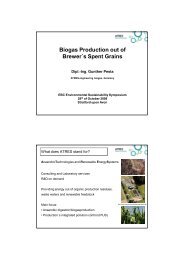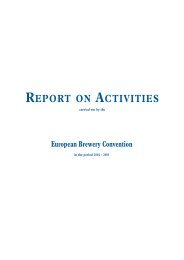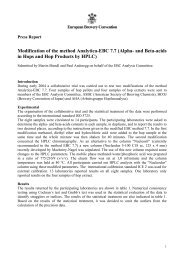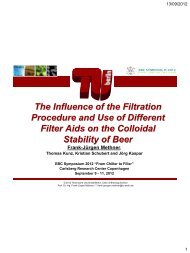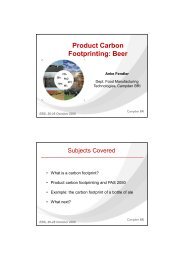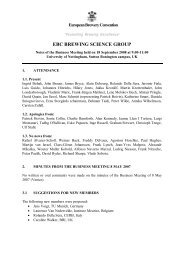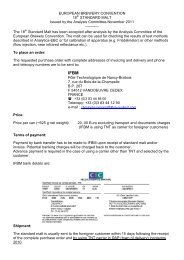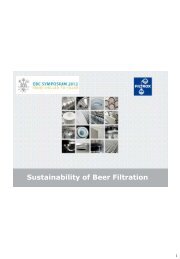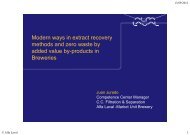the green power of membranes - European Brewery Convention
the green power of membranes - European Brewery Convention
the green power of membranes - European Brewery Convention
Create successful ePaper yourself
Turn your PDF publications into a flip-book with our unique Google optimized e-Paper software.
®<br />
THE GREEN POWER OF MEMBRANES<br />
Reiner Gaub<br />
Pall Food & Beverage<br />
Reiner Gaub, Pall ® Food & Beverage The Green Power <strong>of</strong> Membranes © 2008, Pall Corporation<br />
®<br />
Agenda<br />
• The brewing process – a filtration process<br />
• Sustainability<br />
• Measures<br />
• Clarification <strong>of</strong> beer<br />
• Microbiological stabilization<br />
• Summary<br />
Reiner Gaub, Pall ® Food & Beverage The Green Power <strong>of</strong> Membranes © 2008, Pall Corporation
®<br />
The Brewing<br />
Process<br />
Incoming water<br />
treatment<br />
Yeast<br />
Management<br />
Beer Recovery<br />
from Yeast<br />
Milling<br />
Mashing<br />
Lautering<br />
Boiling<br />
Fermentation<br />
Clarification Fine<br />
Filtration<br />
Whirlpool<br />
Maturation<br />
Bright<br />
Beer Tank<br />
Final<br />
Filtration<br />
Cooling<br />
Cooling<br />
Filling<br />
Reiner Gaub, Pall ® Food & Beverage The Green Power <strong>of</strong> Membranes © 2008, Pall Corporation<br />
®<br />
Membranes<br />
in <strong>the</strong><br />
Brewing<br />
Process<br />
Incoming water<br />
treatment<br />
Yeast<br />
Management<br />
Beer Recovery<br />
from Yeast<br />
Milling<br />
Mashing<br />
Lautering<br />
Boiling<br />
Fermentation<br />
Clarification Fine<br />
Filtration<br />
Whirlpool<br />
Maturation<br />
Bright<br />
Beer Tank<br />
Final<br />
Filtration<br />
Cooling<br />
Cooling<br />
Filling<br />
Reiner Gaub, Pall ® Food & Beverage The Green Power <strong>of</strong> Membranes © 2008, Pall Corporation
®<br />
Sustainability<br />
• www = 32 m hits<br />
• Since 2007 key criteria for company ratings<br />
• Since 5 years increasing attention<br />
• Since 30 years on <strong>the</strong> agenda<br />
• Is experienced by each individual<br />
Reiner Gaub, Pall ® Food & Beverage The Green Power <strong>of</strong> Membranes © 2008, Pall Corporation<br />
®<br />
Green<br />
Power<br />
How to describe GREEN POWER ?<br />
• Carbon foot print<br />
• Water foot print<br />
• Recycling & Disposal<br />
• Health aspects<br />
Reiner Gaub, Pall ® Food & Beverage The Green Power <strong>of</strong> Membranes © 2008, Pall Corporation
®<br />
CO 2<br />
Footprint<br />
Definition UNFCCC<br />
(United Nation Framework <strong>Convention</strong> on Climate Change)<br />
Measure <strong>of</strong> <strong>the</strong> impact, human activities have on <strong>the</strong><br />
environment in terms <strong>of</strong> <strong>the</strong> amount <strong>of</strong> <strong>green</strong> house gases<br />
produced.<br />
Standards<br />
Ecological foot print standards Rev 2006, released June 16th, 2006 by <strong>the</strong> Global Footprint Network<br />
Depending on <strong>the</strong> subject and <strong>the</strong> research question that<br />
is being investigated Ecological footprint studies have<br />
significant differences.<br />
Reiner Gaub, Pall ® Food & Beverage The Green Power <strong>of</strong> Membranes © 2008, Pall Corporation<br />
®<br />
CO 2<br />
Footprint<br />
Measurement<br />
UK Parliamentary Office <strong>of</strong> Sciences and Technology, 2006<br />
Carbon foot print is expressed as a CO 2 equivalent<br />
(kg) which accounts to <strong>the</strong> same global warming<br />
effects <strong>of</strong> different <strong>green</strong> house gases.<br />
Methodologie<br />
WBCSD/WIR global <strong>green</strong> house gas protocol<br />
World Business Council for Sustainable Development.<br />
Footprint standard calculation methods<br />
Ecological foot print standards Rev 2006, Application standard #8<br />
Reiner Gaub, Pall ® Food & Beverage The Green Power <strong>of</strong> Membranes © 2008, Pall Corporation
®<br />
CO 2<br />
Footprint<br />
Raw materials<br />
Transport<br />
Reporting levels<br />
Ecological foot print standards Rev 2006, released June 16th, 2006 by <strong>the</strong> Global Footprint Network<br />
• Scope 1<br />
• Direct emissions resulting from product life cycle<br />
• Scope 2<br />
• Indirect emissions considering pollution from purchased<br />
energy and transport<br />
• Scope 3<br />
• Voluntary emissions not controlled by company,<br />
e.g. subsupplier, disposal<br />
Production<br />
Product use<br />
Distribution<br />
Disposal/Recycle<br />
Reiner Gaub, Pall ® Food & Beverage The Green Power <strong>of</strong> Membranes © 2008, Pall Corporation<br />
®<br />
The Brewing<br />
Process<br />
Benchmarking<br />
DE against Membrane<br />
Reiner Gaub, Pall ® Food & Beverage The Green Power <strong>of</strong> Membranes © 2008, Pall Corporation
®<br />
CO 2<br />
Footprint<br />
From Source to <strong>Brewery</strong> Entry<br />
(example 2 Mio hl brewery)<br />
DE Filtration (200 t/a at 100 g/hl total consumption)<br />
Mining<br />
• Yield 20% to 80%<br />
• 500 – 1.000 t/a raw material<br />
Production<br />
• Sieving, Drying<br />
• Burning (700 1.400 °C)<br />
• CO 2 Footprint – est. 600.000 kg CO 2 /anno<br />
• Reference data for lime at 1,2 kg CO 2 for 1 kg lime at comparable<br />
conditions (970°C for 1h) Source BVK Sept. 2008 Handelsblatt<br />
• Carbon footprint 0,11 kg CO 2 /hl<br />
Distribution<br />
• 25 kg bags<br />
• Long distance distribution<br />
Reiner Gaub, Pall ® Food & Beverage The Green Power <strong>of</strong> Membranes © 2008, Pall Corporation<br />
®<br />
CO 2<br />
Footprint<br />
From Source to <strong>Brewery</strong> Entry<br />
(example 2 Mio hl brewery)<br />
PES membrane based process 0,8 – 1,6 t/a at 50 to 80 lmh<br />
Mining/Raw Materials<br />
• Oil and Oil derivates<br />
• Recycling materials<br />
Transport<br />
• Oil sources Middle East, North Sea, Texas, Russia<br />
• From drilling to rafination (typically Europe, Texas, etc)<br />
Production<br />
• Carbon footprint PES material = 0,36 to 1,1 kg CO 2 /kg<br />
• Data from BASF sustainability report, section Carbon balance 2008<br />
• Carbon footprint 0,0004 kg CO 2 /hl incl. transport & raw materials<br />
Distribution<br />
• Big bulk polymer materials to membrane manufacturing site<br />
• Membranes to breweries<br />
Reiner Gaub, Pall ® Food & Beverage The Green Power <strong>of</strong> Membranes © 2008, Pall Corporation
®<br />
Clarification<br />
DE Filtration<br />
• Batch<br />
• 8 16 h batch length<br />
• 60 120 min downtime<br />
• DE powder handling<br />
• 5 10 kWh additional<br />
• High system volume<br />
• 85 hl vessel volume<br />
* 400 hl/h System at 5 hl/h*m² for DE or 80 lmh for membrane<br />
Membrane<br />
• Continuous<br />
• CIP, 1x in 24 h<br />
• Duration 60 min<br />
• No powder handling<br />
• Low system volume<br />
• 22 hl system volume<br />
Reiner Gaub, Pall ® Food & Beverage The Green Power <strong>of</strong> Membranes © 2008, Pall Corporation<br />
®<br />
Clarification<br />
DE Filtration<br />
• Low chemical usage<br />
• 150 – 250 l NaOH<br />
@ 25 % per month<br />
• Medium water usage<br />
• 0,13 hl/hl beer<br />
• High pre/after runs<br />
• 0,3 to 1 vessel volumes<br />
• Medium <strong>power</strong> cons.<br />
• 0,30,5 kWh/hl beer*<br />
Membrane<br />
* 400 hl/h System at 5 hl/h*m² for DE or 80 lmh for membrane incl. centrifuge<br />
• High chemical usage<br />
• 20–40 hl NaOH@ 25%<br />
• 10–20 hl H 2 O 2 per month<br />
• Low water use<br />
• 0,08 hl/hl beer<br />
• No pre/after runs<br />
• no beer losses<br />
• Medium <strong>power</strong> cons.<br />
• 0,50,7 kWh/hl beer*<br />
Reiner Gaub, Pall ® Food & Beverage The Green Power <strong>of</strong> Membranes © 2008, Pall Corporation
®<br />
Clarification<br />
DE Filtration<br />
Single use <strong>of</strong> product<br />
• Without DE recycling<br />
– 660 t/a wet DE<br />
• @ 100 g/hl dosage<br />
• @ 35% solid content<br />
– Transport Emission<br />
• 39.600 kg CO 2 /a<br />
@ 1.200 g CO 2 /km*²<br />
@ 25 km distance<br />
– Disposal<br />
• Farming, landfill, waste<br />
water<br />
•* MANmm.com/en/Innovation and Competence/Environment<br />
* 400 hl/h System at 5 hl/h*m² for DE or 80 lmh for membrane<br />
Membrane<br />
Multiple use <strong>of</strong> product<br />
• > 500 filtration cycles<br />
– 0,4 – 0,8 t/a<br />
• @ 500 to 1000 cycles<br />
• @ 4,3 kg dry weight<br />
– Disposal<br />
• Municipal waste<br />
• Recycling<br />
– Energy recycling<br />
– Feedstock recycling<br />
Reiner Gaub, Pall ® Food & Beverage The Green Power <strong>of</strong> Membranes © 2008, Pall Corporation<br />
®<br />
Clarification<br />
DE Filtration<br />
• Health exposure<br />
– TRGS 906 (01/2006)<br />
EU # 2724890 (<strong>European</strong> inventory registration <strong>of</strong> chemical substances)<br />
• Kieselguhr calcinated 0,3 mg / m³ A (dust < 12 µm)<br />
• Kieselguhr none calcinated 4 mg / m³ E (dust > 12 µm)<br />
• Cristobalit 0,15 mg / m³ A<br />
• Quarz 0,15 mg / m³ A<br />
• In June 1998 <strong>the</strong> IARC reclassified “crystalline silica”<br />
from group 2A “probable human carcinogen”<br />
to group 1 “ human carcinogen”.<br />
International Agency for Research on Cancer (IARC, an organ <strong>of</strong> <strong>the</strong> WHO)<br />
Reiner Gaub, Pall ® Food & Beverage The Green Power <strong>of</strong> Membranes © 2008, Pall Corporation
®<br />
Clarification<br />
CO2 footprint<br />
water<br />
<strong>power</strong><br />
cleaner<br />
health<br />
disposal<br />
Impact Rating<br />
Low Sustainability impact high<br />
DE<br />
Membrane<br />
Reiner Gaub, Pall ® Food & Beverage The Green Power <strong>of</strong> Membranes © 2008, Pall Corporation<br />
®<br />
Micro<br />
biological<br />
Stabilisation<br />
The Technologies<br />
– Membrane filtration<br />
• Mechanical process<br />
• Multiple use <strong>of</strong> material<br />
• Small volumes<br />
– Pasteurizer<br />
• Thermal process<br />
• Heat & water recovery<br />
Reiner Gaub, Pall ® Food & Beverage The Green Power <strong>of</strong> Membranes © 2008, Pall Corporation
®<br />
Micro<br />
biological<br />
Stabilisation<br />
• Savings by replacing a tunnel pasteurizer<br />
with a Pall CFS filter system<br />
– Energy<br />
• 400.000 kWh/ month<br />
– Water<br />
• 2.000 m³/month<br />
– Waste water<br />
• 1.975 m³/month<br />
– COD waste water<br />
• 3.740 kg/month<br />
– Glas waste (broken bottles)<br />
• 13.800 kg/month<br />
• 350 hl/h performance/ 2 mio hl production<br />
Cold Sterile Filtration in a <strong>Brewery</strong>, S.H<strong>of</strong>fman, Brauwelt 137 Nr 23, 894896<br />
Reiner Gaub, Pall ® Food & Beverage The Green Power <strong>of</strong> Membranes © 2008, Pall Corporation<br />
®<br />
Summary<br />
THE GREEN POWER OF MEMBRANES<br />
• Membranes for clarification<br />
– lower <strong>the</strong> carbon footprint<br />
– reduce water footprint<br />
– are not hazardous<br />
– create no waste issue<br />
– allow recycling<br />
• Membranes for microbiological beer stabilisation<br />
– reduce carbon footprint<br />
– minimize water footprint<br />
Reiner Gaub, Pall ® Food & Beverage The Green Power <strong>of</strong> Membranes © 2008, Pall Corporation



